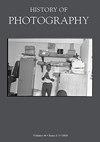Women Photographers of the Pacific World, 1857–1930
IF 0.2
2区 艺术学
0 ART
引用次数: 0
Abstract
reading experience. Particularly striking in this regard are the descriptions of the various apparatuses that Newland invented to create the spectacular visual shows he staged while living and working in Calcutta. It is not just the author’s fine-grained knowledge of past photographic practices and technologies that impresses, however. The reader is also offered a fine demonstration of how to weave elements of contemporary photographic theory into the narrative in a way that helps illuminate the significance of Newland’s inventions for contemporary readers. While the book provides a brilliantly detailed account of the history of the daguerreotype and the nineteenth-century views shows that catered to the era’s vogue for visual spectacle, it could be said to be somewhat light in its treatment of Newland’s life. For instance, we never learn whether Newland married or had children, whether he was from the British lower, middle or upper classes, or even why he left England for the USA. This is no doubt partly a function of the period itself, for Newland was working at time when few official records of people’s lives were kept and indeed, as the authors explain, all that is known of his family background is his mother’s name and the fact that he was her first child and of illegitimate birth. But it may also have been partly a function of the highly competitive nature of Newland’s profession and his itinerant lifestyle, for these meant that he had neither the time nor space to keep records pertaining to his private life or indeed his business. Indeed, the picture that emerges of him is of a man who was not just one of the most hardworking photographers and showmen of his time – he was also one of the most talented and entrepreneurial. In summary, the wide range of media and historical incidents covered by Empire, Early Photography and Spectacle together with the book’s in-depth research render it a valuable resource for scholars of both past and contemporary visual media. This book will also appeal to all those interested in the various visual apparatuses and optical technologies that contributed to the growth both of colonialism and the cultures of entertainment in first half of the nineteenth century.1857-1930年太平洋世界女摄影师
阅读体验。在这方面,特别引人注目的是对纽兰发明的各种装置的描述,这些装置是他在加尔各答生活和工作时为创造壮观的视觉表演而发明的。然而,给人留下深刻印象的不仅仅是作者对过去摄影实践和技术的精细了解。读者还可以很好地展示如何将当代摄影理论的元素融入叙事,从而有助于阐明纽兰的发明对当代读者的意义。虽然这本书对银版印刷术的历史和19世纪的景观展示进行了精彩而详细的描述,迎合了那个时代视觉奇观的流行,但它对纽兰生活的处理可以说有些轻松。例如,我们从未了解纽兰是否结婚或生了孩子,他是否来自英国的下层、中产阶级或上层阶级,甚至他为什么离开英国前往美国。毫无疑问,这在一定程度上是这个时期本身的一个功能,因为纽兰工作的时候,人们的生活几乎没有官方记录,事实上,正如作者所解释的,关于他的家庭背景,人们只知道他母亲的名字,以及他是她的第一个孩子和私生子的事实。但这也可能在一定程度上是纽兰职业的高度竞争性和他流动的生活方式的作用,因为这意味着他既没有时间也没有空间记录他的私人生活,甚至他的生意。事实上,他不仅是那个时代最勤奋的摄影师和表演者之一,也是最有才华和创业精神的人之一。总之,《帝国》、《早期摄影》和《奇观》涵盖了广泛的媒体和历史事件,加上本书的深入研究,使其成为过去和当代视觉媒体学者的宝贵资源。这本书还将吸引所有对各种视觉设备和光学技术感兴趣的人,这些设备和技术促成了19世纪上半叶殖民主义和娱乐文化的发展。
本文章由计算机程序翻译,如有差异,请以英文原文为准。
求助全文
约1分钟内获得全文
求助全文
来源期刊
CiteScore
0.30
自引率
50.00%
发文量
23
期刊介绍:
History of Photography is an international quarterly devoted to the history, practice and theory of photography. It intends to address all aspects of the medium, treating the processes, circulation, functions, and reception of photography in all its aspects, including documentary, popular and polemical work as well as fine art photography. The goal of the journal is to be inclusive and interdisciplinary in nature, welcoming all scholarly approaches, whether archival, historical, art historical, anthropological, sociological or theoretical. It is intended also to embrace world photography, ranging from Europe and the Americas to the Far East.

 求助内容:
求助内容: 应助结果提醒方式:
应助结果提醒方式:


